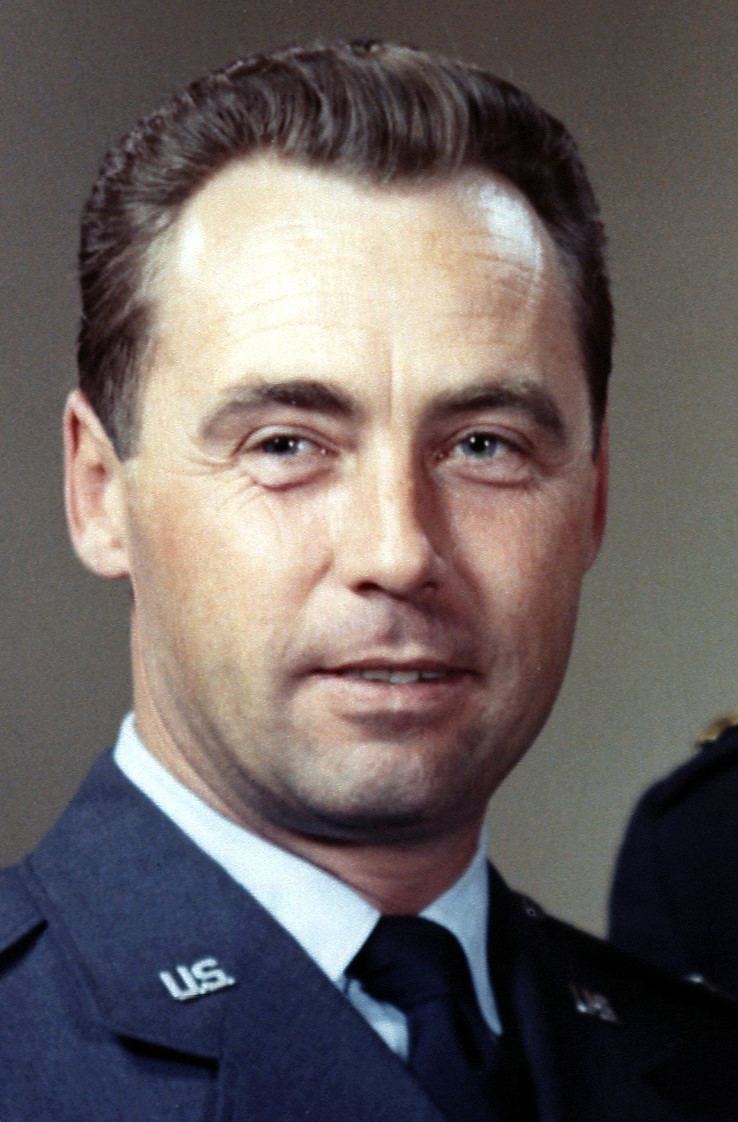Nationality American Selection 1960 Dyna-Soar Group 1 Space missions X-15 Flight 190 Role American Politician | Other names William John Knight Name William Knight Status Deceased Mission insignia Children Steve Knight | |
 | ||
Born November 18, 1929Noblesville, Indiana, U.S. ( 1929-11-18 ) Alma mater Air Force Institute of Technology Grandchildren Christopher Knight, Michael Knight Rank Colonel, United States Air Force | ||
William John "Pete" Knight (November 18, 1929 – May 7, 2004), (Col, USAF), was an American aeronautical engineer, politician, Vietnam War combat pilot, test pilot, and astronaut in the X-20 Dyna-Soar and North American X-15 programs. Knight holds the world's speed record for flight in a winged, powered aircraft.
Contents
- Early life and education
- Personal
- Air Force career
- Political career
- Proposition 22
- Watch
- Awards and honors
- References
As a politician, he is noted as the author of California Proposition 22, which forbade the state from performing or recognizing same-sex marriage.
Early life and education
Knight was born November 18, 1929 in Noblesville, Indiana, to parents William T. Knight (1906–1968) and Mary Emma Knight (1909–1959). Following high school, Knight attended Butler University and Purdue University. He graduated with a Bachelor of Science degree in Aeronautical Engineering from the U.S. Air Force Institute of Technology in 1958.
Personal
Knight was married to Helena Stone and they had three sons, Steve, Peter, and David. Helena preceded Knight in death. Knight remarried and at his death in 2004 he was survived by his widow Gail, a brother, three sons, four stepchildren and 15 grandchildren.
Air Force career
Knight joined the United States Air Force in 1951. While only a Second Lieutenant, he flew an F-89 at the National Air Show in 1954 and won the Allison Jet Trophy.
Starting in 1958, following his graduation from both U.S. Air Force Institute of Technology and the Air Force Experimental Flight Test Pilot School, Knight served as a test pilot at Edwards Air Force Base, California. He was a project test pilot for the F-100, F-101 Voodoo, F-104 Starfighter and later, T-38 and F-5 test programs. In 1960, he was one of six test pilots selected to fly the X-20 Dyna-Soar, which was slated to become the first winged orbital space vehicle capable of lifting reentries and conventional landings. After the X-20 program was canceled in 1963, he completed the astronaut training curriculum through the Aerospace Research Pilot School at Edwards AFB and was selected to fly the North American X-15.
He had more than his share of eventful flights in the X-15. While climbing through 107,000 feet (33,000 m) at Mach 4.17 on June 29, 1967, he suffered a total electrical failure and all onboard systems shut down. After reaching a maximum altitude of 173,000 feet (53,000 m), he calmly set up a visual approach and, resorting to old-fashioned "seat-of-the-pants" flying, he glided down to a safe emergency landing at Mud Lake, Nevada. For his remarkable feat of airmanship that day, he earned a Distinguished Flying Cross.
On October 3, 1967, Knight set a world aircraft speed record for manned aircraft by piloting the X-15A-2 to 4,520 miles per hour (7,274 km/h) (Mach 6.72), a record that still stands today. During 16 flights in the aircraft, Knight also became one of only five pilots to earn their Astronaut Wings by flying an airplane in space, reaching an altitude of 280,500 feet (85,500 m).
After nearly ten years of test flying at Edwards AFB, he went to Southeast Asia in 1968 where he completed a total of 253 combat missions in the F-100. Following his combat tour, he served as test director during development of the F-15 Eagle at Wright Patterson Air Force Base in Dayton, Ohio. He also was the Program Director for the International Fighter (F-5) Program at Wright-Patterson. In 1979, he returned to Edwards AFB, and served as a test pilot for the F-16 Fighting Falcon.
After 32 years of service and more than 6,000 hours in the cockpits of more than 100 different aircraft, he retired from the U.S. Air Force as a Colonel in 1982.
Political career
In 1984, he was elected to the city council of Palmdale, California, and four years later became the city's first elected mayor. In 1992, he was elected to serve in the California State Assembly representing the 36th District. He served in the State Senate representing the 17th District from 1996 until his death on May 7, 2004. Knight's youngest son, Steve Knight served as Assemblyman for the 36th Assembly District from 2008 to 2012, the seat previously held by his father.
Proposition 22
During his term in the Senate, Knight gained statewide attention in 2000 as the author of Proposition 22, a.k.a. the "Knight Initiative," the purpose of which was to ban same-sex marriage: "Only marriage between a man and a woman is valid or recognized in California." The proposition passed with 61.4% approval and 38.6% against. On March 9, 2004, Knight's son, David Knight, who is gay, married his partner during the period when San Francisco performed same-sex marriages in defiance of state law. These marriages were later nullified by the California Supreme Court in 2004. The Court later found Proposition 22 to be unconstitutional in In re Marriage Cases (2008).
Watch
Awards and honors
In the city of Palmdale, Pete Knight High School was opened in his memory. The school began its first year in the school year of 2003-2004 and celebrated its first graduating class in 2007.
